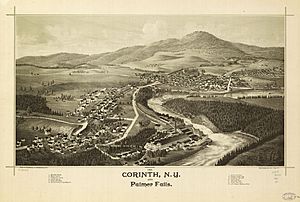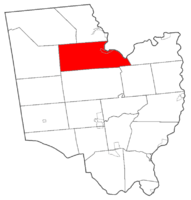Corinth, New York facts for kids
Quick facts for kids
Corinth
|
|
|---|---|

Perspective map of Corinth and Palmer Falls by L.R. Burleigh from 1888 with a list of landmarks
|
|
| Nickname(s):
Gateway to the Adirondacks
|
|

Map highlighting Corinth's location within Saratoga County.
|
|
| Country | United States |
| State | New York |
| County | Saratoga |
| Settled | 1775 |
| Established | 1818 |
| Area | |
| • Total | 58.13 sq mi (150.57 km2) |
| • Land | 56.76 sq mi (147.02 km2) |
| • Water | 1.37 sq mi (3.55 km2) |
| Population
(2010)
|
|
| • Total | 6,531 |
| • Estimate
(2016)
|
6,394 |
| • Density | 112.64/sq mi (43.49/km2) |
| Time zone | UTC-5 (Eastern (EST)) |
| • Summer (DST) | UTC-4 (EDT) |
| Area code(s) | 518 |
| FIPS code | 36-091-18223 |
| Website | www.townofcorinthny.com |
Corinth is a town in Saratoga County, New York, United States. The population was 6,531 at the 2010 census. The town contains a village also named Corinth. The town is on the northeastern border of the county, north of Saratoga Springs. The town is noted as "the snowshoe capital of the world" and is home to Palmer Falls where the Hudson River passes through.
Contents
History
Around 1763, after the French and Indian War, Ebenezer Jessup and his brother Edward from Luzerne began lumbering operations in the town. They floated rafts of logs down the Hudson. To bypass Palmer Falls they landed the rafts at a place called "Jessup's Landing", now the public beach of the Village of Corinth. They loaded the logs onto wagons and carted them around the falls. During the American Revolution the Jessups sided with the Loyalists and fled to Canada, where they commanded a unit known as "Jessup's Loyal Rangers". For a long time the area was known as Jessup's Landing. The first permanent settlement in this area was around 1777, when Joseph Eggleston moved from Wilton to escape British raiders. John W. Taylor moved from Charlton to Jessup's Landing around 1808 and helped organize the Town of Corinth in 1818.
Around 1790 Ambrose Clothier moved from Connecticut and built a cabin near Lake Bonita on Mount McGregor. He had three sons and three daughters, and all his sons were noted fiddlers. The area around Beaver Brook near the Hudson is today known as "Clothier Hollow".Other early settlers in this area were Benjamin Ide, Jonathan Hodges, William Grippen, Lawrence Barber, Jonathan Barrass, and Hathaway Randall.
A third area of settlement was South Corinth (originally Chapman's Corners) along the Kayaderosseras Creek near the border with Greenfield. This area was settled around 1788 by Adam Comstock from Warwick, Rhode Island, who served in the New York State Assembly from 1792 to 1840, and the New York State Senate from 1805 to 1808. Other early settlers were Benjamin Carpenter, Nathaniel Edwards, Frederick Parkman, Jeremiah Eddy, John Purqua, and Washington Chapman.
The town was formed in 1818 from the town of Hadley. The first business was to decide on a name. Mrs. Washington Chapman was allowed to choose the name. She opened her bible randomly to the Epistle to the Corinthians, so the town became Corinth.
Lumbering was important to the early town, which had more than thirty sawmills. After the American Civil War, many paper mills opened in the town.
In 1888, the hamlet of Corinth incorporated as a village.
Geography
According to the United States Census Bureau, the town has a total area of 58.1 square miles (150.6 km²), of which, 56.8 square miles (147.1 km²) of it is land and 1.3 square miles (3.4 km²) of it (2.29%) is water.
The east town line, formed by the Hudson River, is the border of Warren County. The western part of the town is in the Adirondack Park.
Palmer Falls on the Hudson River is located in the town. This was formerly known as "Kah-che-bon-cook", "Hadley Falls", "The Great Falls of the Hudson", or "Palmer's Great Falls". The falls are now named after Beriah Palmer, who at one time owned land along both sides of the river at this point.
New York State Route 9N is a north-south highway.
The Saratoga and North Creek Railway stops in Corinth once daily northbound and southbound on Saturday and Sunday in May and June, and Friday through Tuesday in July through October.
Demographics
| Historical population | |||
|---|---|---|---|
| Census | Pop. | %± | |
| 1820 | 1,490 | — | |
| 1830 | 1,412 | −5.2% | |
| 1840 | 1,365 | −3.3% | |
| 1850 | 1,501 | 10.0% | |
| 1860 | 1,558 | 3.8% | |
| 1870 | 1,500 | −3.7% | |
| 1880 | 1,737 | 15.8% | |
| 1890 | 2,124 | 22.3% | |
| 1900 | 3,104 | 46.1% | |
| 1910 | 3,102 | −0.1% | |
| 1920 | 3,696 | 19.1% | |
| 1930 | 3,760 | 1.7% | |
| 1940 | 4,478 | 19.1% | |
| 1950 | 4,879 | 9.0% | |
| 1960 | 5,167 | 5.9% | |
| 1970 | 5,442 | 5.3% | |
| 1980 | 5,216 | −4.2% | |
| 1990 | 5,935 | 13.8% | |
| 2000 | 5,985 | 0.8% | |
| 2010 | 6,531 | 9.1% | |
| 2016 (est.) | 6,394 | −2.1% | |
| U.S. Decennial Census | |||
As of the census of 2000, there were 5,985 people, 2,331 households, and 1,662 families residing in the town. The population density was 105.4 people per square mile (40.7/km2). There were 2,804 housing units at an average density of 49.4 per square mile (19.1/km2). The racial makeup of the town was 98.28% White, 0.20% Black or African American, 0.15% Native American, 0.20% Asian, 0.10% Pacific Islander, 0.30% from other races, and 0.77% from two or more races. Hispanic or Latino of any race were 0.79% of the population.
There were 2,331 households, out of which 32.6% had children under the age of 18 living with them, 55.2% were married couples living together, 10.7% had a female householder with no husband present, and 28.7% were non-families. Of all households, 23.4% were made up of individuals, and 12.8% had someone living alone who was 65 years of age or older. The average household size was 2.57 and the average family size was 2.99.
In the town, the population was spread out, with 26.0% under the age of 18, 7.3% from 18 to 24, 28.6% from 25 to 44, 23.8% from 45 to 64, and 14.2% who were 65 years of age or older. The median age was 38 years. For every 100 females, there were 96.6 males. For every 100 females age 18 and over, there were 94.0 males.
The median income for a household in the town was $35,199, and the median income for a family was $41,732. Males had a median income of $32,227 versus $25,146 for females. The per capita income for the town was $16,003. About 7.8% of families and 11.9% of the population were below the poverty line, including 14.7% of those under age 18 and 6.4% of those age 65 or over.
Communities and locations
- Corinth: A village by the Hudson River in the eastern part of the town, located on NY-9N.
- Daly's Creek: A stream in the northwest part of Corinth running into the Great Sacandaga Lake.
- Efner Lake: A lake near the north town line, south of County Road 10 (West Mountain Road).
- Hunt Lake: A lake east of Efner Lake.
- Jenny Lake: A lake east of Efner Lake.
- Lake Bonita: A lake in the southeast corner of the town.
- Mount McGregor: A location in the southeast part of the town.
- Palmer: A hamlet east of Corinth village on County Road 24 (Palmer Avenue).
- Randall Corner: A hamlet in the southeast part of the town on County Road 25 (Spier Falls Road).
- South Corinth: A hamlet near the south town line on NY-9N.
- Woodland Lake: A lake southeast of Corinth village.
Transportation
New York State Route 9N is a north-south highway.
The Saratoga and North Creek Railway used to stop in Corinth once daily northbound and southbound on Saturday and Sunday in May and June, and Friday through Tuesday in July through October.
Images for kids
See also
 In Spanish: Corinth (Nueva York) para niños
In Spanish: Corinth (Nueva York) para niños



